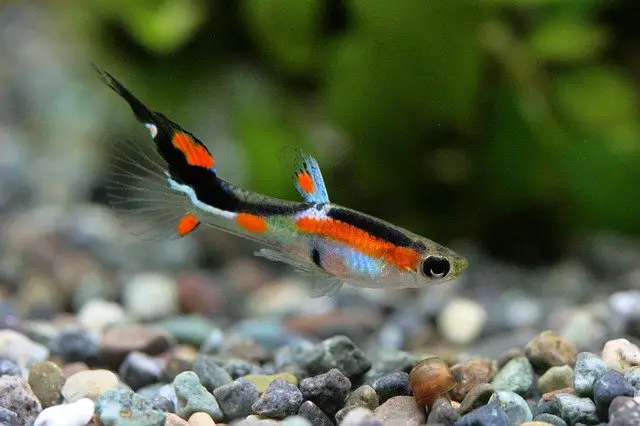Perhaps you have a freshwater aquarium and some of your fish have recently spawned. If there’s too many inhabitants in the tank, you may now be wondering what to do with the extra fish? Well, you can give them away or sell them, which may then require shipping them to their new homes.
Nowadays with the online world you can also order fish from a supplier and have them shipped to you. Regardless of whether you are shipping the fish or a retailer is, all of the information in this article applies either way.
So, the question now is, ‘how long can fish live during shipping?’
If fish are packaged properly for the purpose of shipping, they can live up to 3 days in a bag. Adding an ammonia detoxifying product to the water in the bag will help counteract the buildup of toxins that (if left for too long in large amounts) can kill fish. It’s imperative that fish reach their destination within 72 hours of shipping or they’ll die from suffocation.
Now that you know you can successfully ship live fish, provided they’re prepared and bagged well, let’s take a closer look at this topic together and in more detail. I’ll explain how to properly package live fish, what the cost is to transport, and what to watch out for once they’ve arrived. I’ll also discuss the implications shipping has on their overall health and if it’s cruel to confine them to a bag for 3 days.
So, if your interest is now piqued and you want to learn more about shipping and receiving live fish, then let’s begin!
How Long Can Tropical Fish Survive in Transit?
Most tropical fish can survive in transit for up 3 days, provided they’ve been properly prepared and packaged for their journey. What usually causes fish death during transportation is the buildup of toxic ammonia in the bag. Adding a detoxifying product to the water prior to shipping is recommended.
Regardless of how well you’ve prepared and packaged the fish, it must be received within 48 to 72 hours after shipping. Any longer than that and the fish will die from suffocation and/or toxic overload. For more information, please see below under the subheading entitled: How to Pack Live Fish for Shipping?
Can You Mail Fish Live?
You can ship live fish through most local postal service outlets, provided you adhere to their packaging guidelines and labelling requirements. Other transport centers such as UPS and FedEx will also ship live fish, if given proper notification in advance and pre-packaged according to their stipulations.
How Much Does It Cost to Ship a Live Fish?
Pet/fish stores charge different rates to ship fish, depending on what and how many you purchase. Sometimes they’ll waive the shipping fee if you spend a certain amount of money. Prices will vary from company to company and from region to region.
When it comes to shipping fish yourself, fees will depend upon where you live and the transport agency you choose. It’s best to call your local postal service/delivery company in advance or check out their website for more information. Make sure to specify clearly that you intend to ship live fish and that they must arrive at their destination in 72 hours – preferably less.
How Long Can Fish Survive Without Oxygen?
Fish, like all other living creatures, need oxygen to survive. If you intend to ship fish to a new location, most will only live 2 or 3 days in a bag without oxygen. Therefore, it’s imperative that you make the proper arrangements beforehand to ensure they reach their destination within 48 to 72 hours.
Can Fish Suffocate in Bags?
After more than 3 days in a sealed bag, fish will ultimately suffocate and die. The water inside the bag runs out of oxygen quickly once it’s sealed with the fish inside. That’s why it’s important to leave room at the top of the bag for air. If you fill the bag completely with water, the fish will die en route.
Can You Transport Fish in a Ziploc Bag?
You can transport fish in any plastic container (including a Ziploc bag) for a short distance. Ziploc bags are best used for temporarily storing fish. They’re okay for bringing a new fish home from the pet store and for acclimatizing it to the tank. Ideally, the fish should remain in the bag no longer than 6 to 9 hours.
How to Pack Live Fish for Shipping?
To successfully ship a live fish, you must purge the fish by removing as much waste from its body as possible before bagging. This helps prevent dangerous ammonia buildup, which can result in death while en route. The steps for properly packing live for shipping include the following:
- On the night before shipping, remove the fish from the tank and place it in covered bucket with some tank water at room temperature.
- The next morning, remove the fish carefully from the bucket (which will be very dirty as the slow drop in temperature combined with the stress from the catch will cause the fish to relieve itself).
- Add 2 to 3 drops of API Ammo-Lock (available online through Amazon) to the bag which will bind with the ammonia excreted from the fish and prevent it from building up.
- Send a note with the package outlining the importance of acclimatizing the fish before placing it in the aquarium. The steps include the following:
- Pour the fish along with some transport water into a container and then add some tank water to increase the temperature slightly.
- Gradually add more tank water to bring the temperature in the bucket to within 3 degrees Fahrenheit of that in the tank.
- Using a net, gently remove the fish from the container and place the fish in the tank – discard the transport water.
- Mark the package ‘Fragile’ and send it via your local postal service’s fastest transport option. Ensure you’ve followed the shipping guidelines, otherwise the package may be delayed.

What Happens to Fish After Shipping?
After transporting, fish are likely to exhibit signs of distress. These include frantically swimming about the tank or possibly not swimming much at all! They may also exhibit symptoms associated with oxygen deprivation such as lethargy, gasping for air, rapid gill movements or loss of equilibrium.
Therefore, it’s imperative to keep a close eye on your new fish after they’ve been shipped from one location to another. Do not add light or food right away – allow the fish time to acclimate to they’re new tank environment. Once they’ve settled in, introduce light and feed sparingly with dried fish flakes.
Is it Cruel to Confine Fish to a Bag?
Confining fish to a bag (or bowl) is indeed cruel, in my opinion as an experienced aquarium hobbyist. Bags restrict both oxygen and space – both of which are vital to fish health. You should provide at least 24-square inches of water for every inch of fish. In other words – the more room they have, the better!
If kept for too long in a cramped space, fish ultimately become frustrated. They may exhibit signs of aggression or stress, not to mention suffer from physical deformities including stunted growth, spinal abnormalities, and atrophied muscles.
Conclusion
To conclude, if fish are packaged properly, they can live up to 72 hours in a bag for the purpose of transportation. It’s recommended that you add an ammonia detoxifying product to the bag to help neutralize toxins in the water. High toxicity will often result in the death of the fish in-transit. Should it take longer than 3 days for the fish to arrive at its destination, it will likely suffocate from lack of oxygen.
I trust this article has been of help to you. Thanks for reading and good luck with the process of rehoming of your fish.
Related Posts
How to Transport Fish Safely [Tips to Safely Moving Your Fish]
Is It Ethical to Keep Fish in A Tank? [A Feel-Good Explanation]






